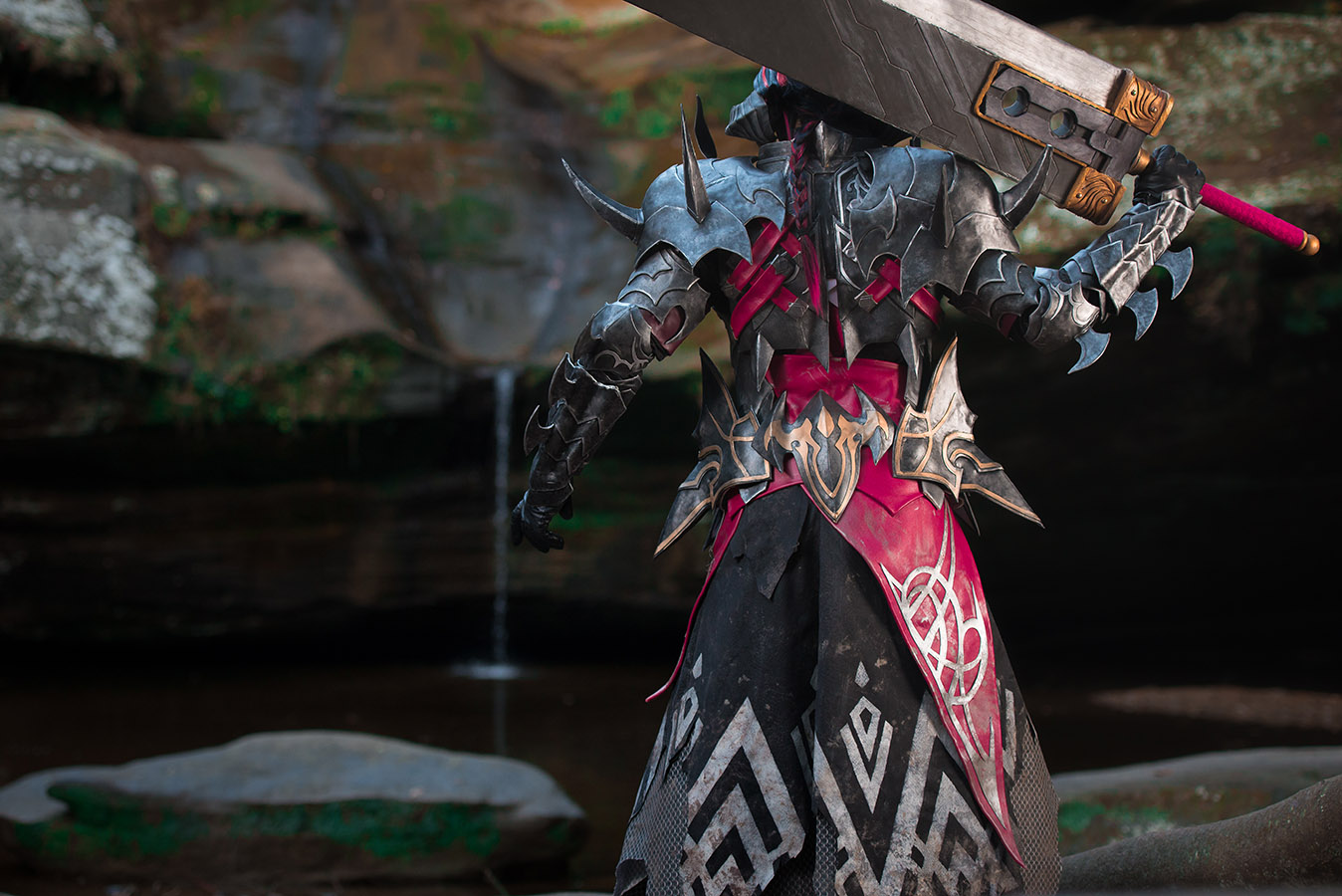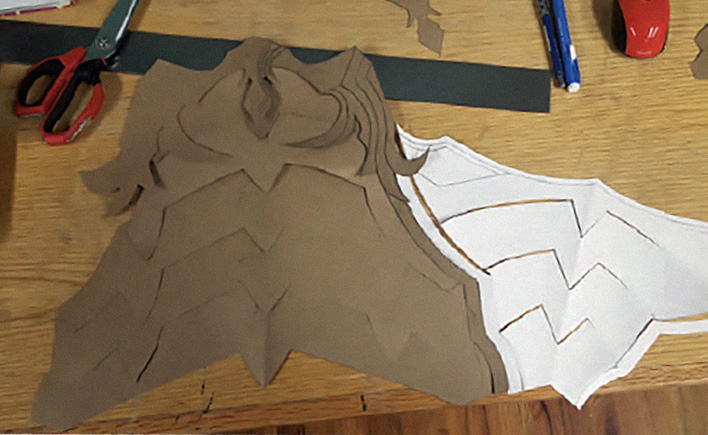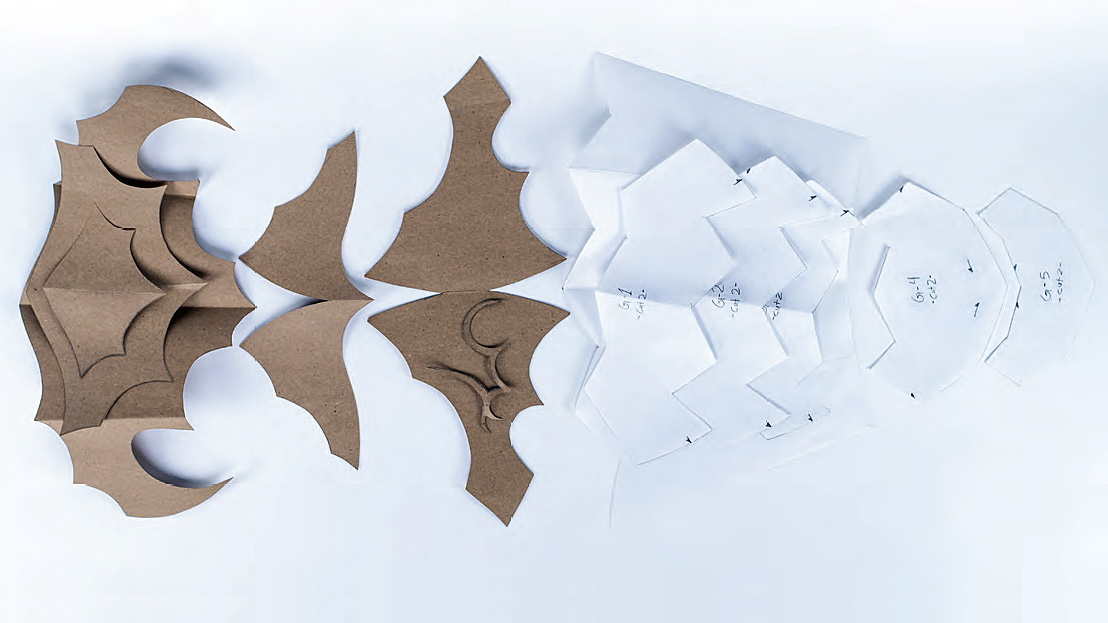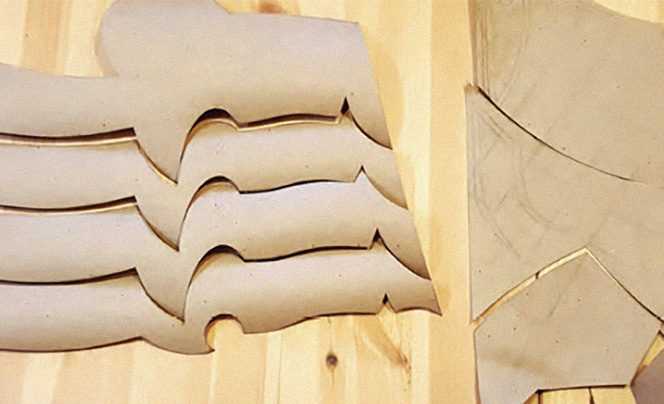 by Kyle Mathis
by Kyle Mathis
photos by Tim Robinson
Armor costumes have grown in popularity exponentially over the past few years. Much of this has been attributed to the growing availability of higher quality thermal plastics and foams for armor and prop construction. As more people take interest in this creative hobby, the need for instruction has grown as well. So how does one begin making armor? Unlike regular clothing, fantasy armors have very different structures, and require their own unique guidelines to create them. Today we will delve into the process of patterning out armor for costumes.
Patterning is the foundation for any outfit, whether it be cloth, plastic, leather, metal, or otherwise. To create a pattern based on an existing design, look for as many reference pictures as possible. It could be concept art, fan art, screenshots, etc. If someone else has already tackled the costume, you might draw inspiration from them as well. Full body shots for the front, sides, and back are excellent, but it’s also a good idea to obtain references for unique angles and fine details. Be aware of any inconsistencies that may occur between different types of references. For example, a concept sketch for a video game armor may have different details or proportions than the 3D render finalized in the game.This tends to be a blessing rather than a curse, as it offers more freedom to choose what you like and don’t like between your references. Take note of these inconsistencies so they don’t potentially throw you off course later. As you work on the project, you can figure out which references are most helpful to hold onto if things get overwhelming. But it’s safer to start with more than you might need. Supplies:
Supplies:
• Glad Press’n Seal, or a plastic wrap of some kind: This is to wrap around parts of your body to create an initial patterning shape.
• Paper: I prefer large pieces; Home Depot carries large rolls of brown builder’s paper.
• Pencils and erasers: You will probably be making adjustments to your pattern sketches, so pencils with erasers are ideal.
• Rulers and straight edges: I recommend investing in a larger ruler and/or T-square to help with longer lines. Curved and shaped rulers can also be beneficial if you aren’t as skilled with organic lines.
• Scissors: Cheap scissors are fine, though more industrial scissors will be easier to use for thicker materials. Designate these scissors as exclusive to your crafting materials. Do not use them for cutting fabric or wigs.
• Masking tape: Use to connect pattern pieces together as you test them out.
• Camera: This is optional, but documenting your work as you go will help retrace your steps in later projects. Sharing your progress on social media is also an opportunity to gain support and energy from your friends and fellow costumers.
• Work space: You will need a decent table or floor space to work on. This may seem like common sense, but finding the right space for a project can sometimes be difficult. Give yourself enough room to spread out and get messy.
Utilizing your reference images, take measurements that correspond to your body such as the length of your forearm, hand width, shoulder width, etc. Always compare the costume to your own body proportions. It doesn’t matter how big, small, or strangely shaped a character is; the end goal is to make the shapes fit with your own.This is especially important for armor because unlike clothing it has little or no give to it. Sometimes it helps to have a friend help you draw/cut out shapes while they are on you, or you could buy a mannequin/dress form that can adjust to your size. A duct tape dummy is fantastic for draping if you want a body double. Use plastic wrap or Press’n Seal to wrap around a part of your body, such as your forearm, and then cut it open.This will be a basic shape of your body part that you can lay flat and use as a guide when creating the final shape of your armor piece (such as a bracer). For more organic shapes, you might need to cut a few darts to lay the piece flat. This technique is most useful for limbs and helmets.
Use plastic wrap or Press’n Seal to wrap around a part of your body, such as your forearm, and then cut it open.This will be a basic shape of your body part that you can lay flat and use as a guide when creating the final shape of your armor piece (such as a bracer). For more organic shapes, you might need to cut a few darts to lay the piece flat. This technique is most useful for limbs and helmets. You can alternatively trace around different body parts to create a starting point. If you trace the outline of your arm, and then add a couple of inches to each side, you’ll have a rough half-piece of the arm for your pattern. Most shapes found in armor can lie flat when broken down. Always look for basic shapes such as circles, squares, and triangles. If it helps to draw out basic shapes first and connect the dots to make an armor piece, then that’s one possible solution. Your pattern pieces don’t need to be clean to be effective, and you can always retrace your pattern on a clean piece of paper/cardboard once you have the shapes to your liking. Don’t be afraid to make mistakes along the way. The whole purpose of patternmaking is trial and error with cheaper materials until it’s perfected, and then the final pattern can be applied to the actual costume armor materials.
You can alternatively trace around different body parts to create a starting point. If you trace the outline of your arm, and then add a couple of inches to each side, you’ll have a rough half-piece of the arm for your pattern. Most shapes found in armor can lie flat when broken down. Always look for basic shapes such as circles, squares, and triangles. If it helps to draw out basic shapes first and connect the dots to make an armor piece, then that’s one possible solution. Your pattern pieces don’t need to be clean to be effective, and you can always retrace your pattern on a clean piece of paper/cardboard once you have the shapes to your liking. Don’t be afraid to make mistakes along the way. The whole purpose of patternmaking is trial and error with cheaper materials until it’s perfected, and then the final pattern can be applied to the actual costume armor materials. A large aspect of patterning comes from understanding how the armor functions on the character. Something to consider is that in all forms of media apart from live action, the artists are usually guilty of drawing/rendering armor in ways that allow them to distort for the sake of the animation. In real life, armor doesn’t stretch with your body, so you won’t always be able to replicate the mobility of a set of armor to the extent it has in a videogame. You will also need to figure out how all the pieces connect to each other in a functional manner.There are plenty of characters out there who are shirtless but have magically attached pauldrons with no visible straps. Sometimes a bit of artistic license needs to be taken for the sake of practicality. Elastic straps are my favorite method for attaching the various layers of armor together, because it provides extra flexibility and movement. Making notes of this while you pattern will help alleviate any stress later when you are constructing the costume.
A large aspect of patterning comes from understanding how the armor functions on the character. Something to consider is that in all forms of media apart from live action, the artists are usually guilty of drawing/rendering armor in ways that allow them to distort for the sake of the animation. In real life, armor doesn’t stretch with your body, so you won’t always be able to replicate the mobility of a set of armor to the extent it has in a videogame. You will also need to figure out how all the pieces connect to each other in a functional manner.There are plenty of characters out there who are shirtless but have magically attached pauldrons with no visible straps. Sometimes a bit of artistic license needs to be taken for the sake of practicality. Elastic straps are my favorite method for attaching the various layers of armor together, because it provides extra flexibility and movement. Making notes of this while you pattern will help alleviate any stress later when you are constructing the costume.
Figure out which layers of armor need to be able to move with you, and which ones won’t move at all. The ones that move can use straps to anchor them to each other, while the static layers can be consolidated. For example, a gauntlet with several layers between the wrist and elbow can be glued together because the forearm won’t bend, but you might use elastic straps to connect the forearm to the elbow piece to allow movement. You can typically draw out your pattern pieces in this fashion: start with one shape, and then break it down into individual layers. Consider extra allowances for overlapping layers when you are ready to cut them out from the final material. Drawing everything together first will help you to keep a fluid design.
 Once you have created your finalized pattern, you may consider tracing a copy so you have a backup in case anything goes wrong, or if you need to make further alterations later. Having a fully intact pattern can also be beneficial beyond your current project if you decide to make duplicates for other people, or start a new project with similarities to your current one.
Once you have created your finalized pattern, you may consider tracing a copy so you have a backup in case anything goes wrong, or if you need to make further alterations later. Having a fully intact pattern can also be beneficial beyond your current project if you decide to make duplicates for other people, or start a new project with similarities to your current one.
Next: Constructing The Armor


